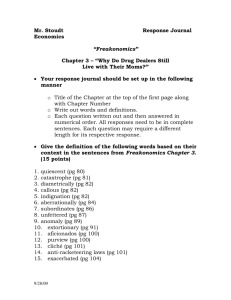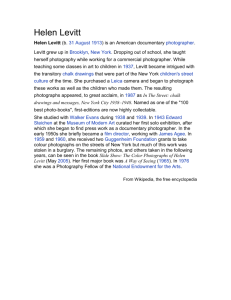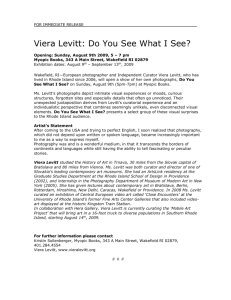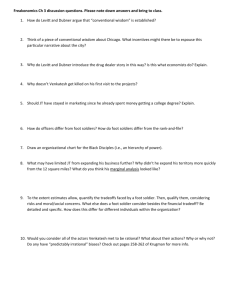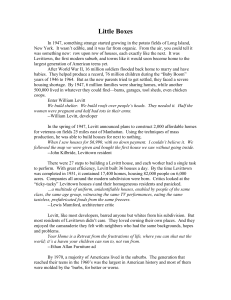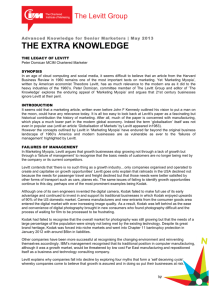WILLIAM LEVITT , By: Lacayo, Richard, Time, 0040781X, 12/07/98
advertisement
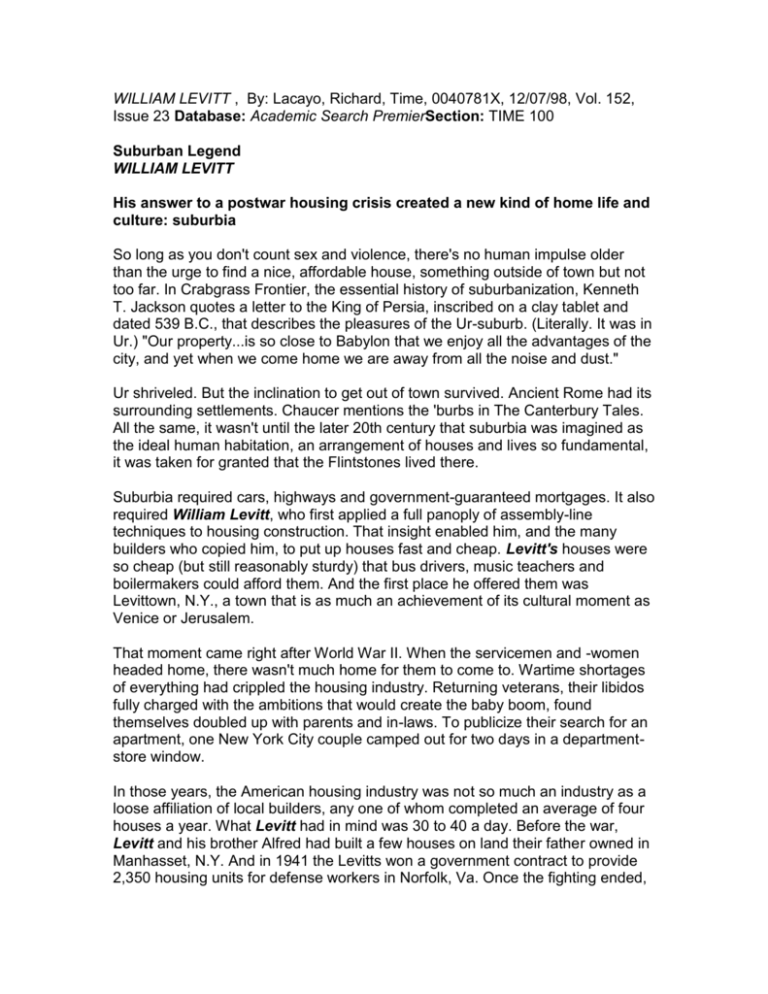
WILLIAM LEVITT , By: Lacayo, Richard, Time, 0040781X, 12/07/98, Vol. 152, Issue 23 Database: Academic Search PremierSection: TIME 100 Suburban Legend WILLIAM LEVITT His answer to a postwar housing crisis created a new kind of home life and culture: suburbia So long as you don't count sex and violence, there's no human impulse older than the urge to find a nice, affordable house, something outside of town but not too far. In Crabgrass Frontier, the essential history of suburbanization, Kenneth T. Jackson quotes a letter to the King of Persia, inscribed on a clay tablet and dated 539 B.C., that describes the pleasures of the Ur-suburb. (Literally. It was in Ur.) "Our property...is so close to Babylon that we enjoy all the advantages of the city, and yet when we come home we are away from all the noise and dust." Ur shriveled. But the inclination to get out of town survived. Ancient Rome had its surrounding settlements. Chaucer mentions the 'burbs in The Canterbury Tales. All the same, it wasn't until the later 20th century that suburbia was imagined as the ideal human habitation, an arrangement of houses and lives so fundamental, it was taken for granted that the Flintstones lived there. Suburbia required cars, highways and government-guaranteed mortgages. It also required William Levitt, who first applied a full panoply of assembly-line techniques to housing construction. That insight enabled him, and the many builders who copied him, to put up houses fast and cheap. Levitt's houses were so cheap (but still reasonably sturdy) that bus drivers, music teachers and boilermakers could afford them. And the first place he offered them was Levittown, N.Y., a town that is as much an achievement of its cultural moment as Venice or Jerusalem. That moment came right after World War II. When the servicemen and -women headed home, there wasn't much home for them to come to. Wartime shortages of everything had crippled the housing industry. Returning veterans, their libidos fully charged with the ambitions that would create the baby boom, found themselves doubled up with parents and in-laws. To publicize their search for an apartment, one New York City couple camped out for two days in a departmentstore window. In those years, the American housing industry was not so much an industry as a loose affiliation of local builders, any one of whom completed an average of four houses a year. What Levitt had in mind was 30 to 40 a day. Before the war, Levitt and his brother Alfred had built a few houses on land their father owned in Manhasset, N.Y. And in 1941 the Levitts won a government contract to provide 2,350 housing units for defense workers in Norfolk, Va. Once the fighting ended, they brought the lessons of that experience to 1,000 acres of potato farms on New York's Long Island 25 miles east of Manhattan. On July 1, 1947, Levitt, then 40, broke ground on the first of what would be 17,000 homes. He could build fast because he had broken down the construction process into 27 operations, then mustered specialized teams to repeat each operation at each building site. Twenty acres were set aside as an assembly point, where cement was mixed and lumber cut. Trucks would deliver parts and material to homesites placed at 60-ft. intervals. Then the carpenters, tilers, painters and roofers arrived, each in his turn. There was a team for white paint, another for red. One worker's sole daily task was to bolt washing machines to floors. PHOTO (BLACK & WHITE): LEVITT'S CREWS BUILT 30 TO 40 HOUSES DAILY USING ASSEMBLY-LINE TECHNIQUES Levitt liked to compare himself to General Motors. "We channel labor and materials to a stationary outdoor assembly line instead of bringing them together inside a factory." To keep down lumber costs, the Levitts bought their own forests and built a sawmill in Oregon. They purchased appliances direct from the manufacturer, cutting out the distributor's markup. They even made their own nails. Levitt's methods kept costs so low that in the first years the houses, which typically sat on a seventh-of-an-acre lot, could sell for just $7,990, a price that still allowed the Levitts a profit of about $1,000. (They sell today for about $155,000.) PHOTO (BLACK & WHITE): SOME ASSEMBLY REQUIRED: A PREFAB HOME IN COMPONENT PARTS Yet however much it may have been a triumph of free enterprise, Levittown depended on massive government assistance. The Federal Housing Administration guaranteed the loans that banks made to builders. Then the Veterans Administration gave buyers low-interest mortgages to purchase those houses. Thus the risk to the lenders was small, and so were the houses: 750 sq. ft., two bedrooms, living room and kitchen, with an unfinished second floor and no garage. All the same, compared with the cramped arrangements of the cities, even a place that size seemed sumptuous and full of potential. Levitt understood this well enough to see himself as more than a builder. He was a prime facilitator of the American Dream in its cold war formulation. "No man who owns his own house and lot can be a communist," he once said. "He has too much to do." The Levitt men were a typical family. They loved each other. They were also a cocoon of misfits who drove each other crazy. Father Abe was a onetime Brooklyn lawyer and would-be philosopher. Bill recalled that Abe liked to give the impression that he knew the distance in light-years to every star. Abe eventually became Levittown's unofficial landscape theorist. He could face a reporter with a fistful of dahlias and tell him, with a straight face: "Every man has a right to flowers!" Brother Alfred designed the houses and grumbled about how credit always went to Bill, the idea man, organizer and salesman. On Saturdays, in a lordly mood that can only be imagined by anyone who has not built his own town, Levitt would drive his black Cadillac convertible around the streets of his town, checking out what the citizens were doing across the abundant stage he had constructed for them, his ears attuned to local gossip, his eyes to lawn maintenance. (In the early years, householders who didn't mow their grass would find Levitt gardeners dispatched to do it and a bill for the job in their mailbox.) He was the consummate marketing guy, unmoved by books, paintings or music. His first wife once complained that she had dragged him to see Death of a Salesman but couldn't get him to identify with the title character. In the larger culture, Levitt's achievement was contested ground. Levittown entered 20th century folklore as the place where democratic equality edged into an unnerving conformity. By stamping whole townships onto old farmland, Levitt brought the machine into the garden in a very literal way. Unlike the automobile or the radio, the home was an ancient possession, a thing too intimate to be mass-produced without offending notions of Yankee individuality that were already under intense pressure from modernity. And as Levittown matured, suburbia itself began to look like humanity at room temperature, a place where the true countryside was denatured, while the true civilization of the cities collapsed into strip malls and dinner theater. Within that context, Levittown became the anti-Williamsburg: Not a re-creation of some idealized past but a living glimpse of the ticky-tacky future. The social critic Lewis Mumford called it "a low-grade uniform environment from which escape is impossible." Levittown was also tainted at birth by the offhand racism of midcentury America. Though Levittown is racially mixed today, for years Levitt's sales contracts barred resale to African Americans. He once offered to build a separate development for blacks but refused to integrate his white Levitt developments. "We can solve a housing problem, or we can try to solve a racial problem," he once said. "But we can't combine the two." In 1963 his all-white policies led to civil rights demonstrations at another Levitt subdivision, in Bowie, Md. PHOTO (COLOR): LEVITT HELPED CREATE AN AFFORDABLE SUBURBAN LIFE-STYLE THAT IS BOTH BLESSED AND CURSED BY CONFORMITY [Aerial view of suburban community] Building modest homes made Levitt rich. In 1968, after his company had built more than 140,000 houses around the world, Levitt & Sons was sold to ITT Corp. for $92 million in stock, most of which went to him. That fortune bought, among other things, a 237-ft. yacht, La Belle Simone, named for his third wife, and a 30-room mansion in Mill Neck, N.Y. But the deal barred him from the domestic construction business for 10 years. Within four years, the ITT stock, which he had been using as collateral to build subdivisions in places like Iran, Venezuela and Nigeria, lost 90% of its value. When those foreign projects foundered, he was left with millions of dollars in debt. Long before his death in 1994, Bill Levitt fully understood that it was Levittown, a working stiff's utopia, that had been his great and intricate achievement. Levittown isn't a visionary product of high design. No major architect went near the place. It was what you get when a canny businessman sees a massive public appetite and applies capital and logistics in a timely fashion. Unlike the workers' housing that Le Corbusier designed near Bordeaux in France, where individual touches by the mere inhabitants offend the architect's conception, Levitt homes were made to be customized. The avid householders of Levittown got busy, adding porches, dormers and new wings, the outcroppings of anybody's headlong life. The line on their town used to be that Levitt houses were indistinguishable from one another, and the people would be too. But the place is now, as a town is supposed to be, a work in progress, a setting that can be held to the light at any angle. And William Levitt, a man who just about never read a novel, turned out to be the author of an entire world. BORN Feb. 11, 1907, in Brooklyn, N.Y. * 1924 Enters NYU, staying until his junior year * 1927 Takes a job in his father's law firm * 1929 Levitt & Sons starts work on its first house * 1941 With brother Alfred, builds housing for defense workers in Norfolk, Va. * 1947 Starts transforming farmland on New York's Long Island into Levittown * 1968 Sells his company to ITT for $92 million * 1994 Dies Jan. 28 in Manhasset, N.Y. PHOTO (BLACK & WHITE): LEVITT SOLD OUT FOR $92 MILLION BUT LATER LOST MOST OF IT [William Levitt] PHOTO (BLACK & WHITE): WITH UNCLE SAM PROVIDING CHEAP LOANS, THE HOUSES WERE SNAPPED UP QUICKLY [People viewing model homes] PHOTO (BLACK & WHITE): BILL SOLD; BROTHER AL, RIGHT, DESIGNED; FATHER ABE OPINED [William Levitt, Abe Levitt and Alfred Levitt] Richard Lacayo, who writes about politics and culture for TIME, grew up in Levittown ON THE HOME-BUILDING FRONT Having a house is a singular ideal for Americans, who have one of the highest rates of home ownership. That explains the popularity of such housing trends as: THE CATALOG HOUSE From 1908 to 1940, Sears reigned in mail-order houses, selling 100,000, some for as little as $107. They came in 450 styles, from the bungalow "Avalon," with its wraparound porch, to the neoclassical "Magnolia," complete with a porte cochere and a two-story portico. THE RANCH; THE SPLIT LEVEL Based on Frank Lloyd Wright's prairie-style homes, these stripped down, low-slung houses with attached garages became the quintessential style for returning vets armed with G.I. loans. They sprouted in suburban developments and came with such fruits of victory as backyards and dishwashers. RESTORATION Spurred on by the senseless destruction of historic buildings such as New York City's Pennsylvania Station, citizens began exploring urban renewal. Many started by reclaiming row houses, giving rise to the $130 billion a year home-improvement industry. Their work has created a thriving market for everything from replacement brassware to traditional shutters to mail-order greenhouses. THE GATED COMMUNITY Many developments, mostly those where owners fear for their safety, have erected barriers and hired security patrols. The U.S. now contains more than 20,000 such locales. In the process, some argue, they have created the anticommunity, a society cut off from its surroundings. Copyright of Time is the property of Time Inc. and its content may not be copied or e-mailed to multiple sites or posted to a listserv without the copyright holder`s express written permission. However, users may print, download, or e-mail articles for individual use. Source: Time, 12/07/98, Vol. 152 Issue 23, p148, 4p © 2004 EBSCO Publishing.
